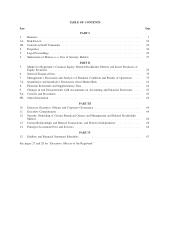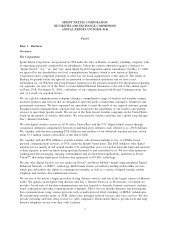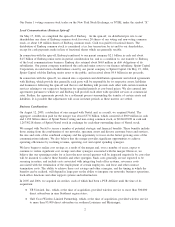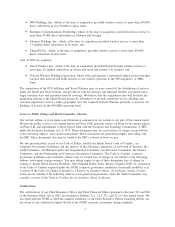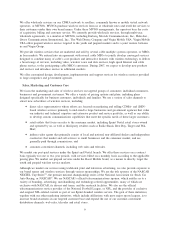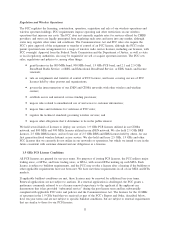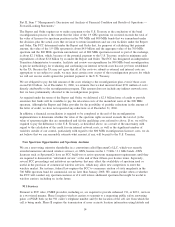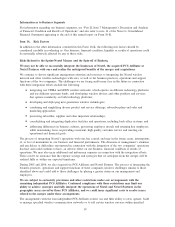Sprint - Nextel 2006 Annual Report Download - page 12
Download and view the complete annual report
Please find page 12 of the 2006 Sprint - Nextel annual report below. You can navigate through the pages in the report by either clicking on the pages listed below, or by using the keyword search tool below to find specific information within the annual report.provided by cable MSOs, as consumers increase their use of cable MSOs as alternatives to local and long
distance voice communications providers, by providing large cable MSOs with local and long distance voice
communications service, which they offer as part of their bundled service offerings.
Products and Services
Through our Long Distance segment, we provide a broad suite of wireline voice and data communications
services, including domestic and international data communications using various protocols such as MPLS
technologies, as well as IP, ATM, frame relay and managed network services and voice services. We also
provide services to cable MSOs that resell our long distance service and/or use our back office systems and
network assets in support of their telephone service provided over cable facilities primarily to residential end
user customers. Although we continue to provide voice services to residential consumers, we no longer
actively market those services. Our Long Distance segment markets and sells its services primarily through
direct sales representatives. We also provide voice and data services to our Wireless segment.
Competition
Our Long Distance segment competes with AT&T, Verizon Communications, Qwest Communications, Level 3
Communications, Inc., other major local incumbent operating companies, cable operators and other telecom-
munications providers in all segments of the long distance communications market. Some competitors are
targeting the high-end data market and are offering deeply discounted rates in exchange for high-volume
traffic as they attempt to utilize excess capacity in their networks. In addition, we face increasing competition
from other wireless and IP-based service providers. Many carriers are competing in the residential and small
business markets by offering bundled packages of both local and long distance services. Competition in long
distance is based on price and pricing plans, the types of services offered, customer service, and communica-
tions quality, reliability and availability. Our ability to compete successfully will depend on our ability to
anticipate and respond to various competitive factors affecting the industry, including new services that may be
introduced, changes in consumer preferences, demographic trends, economic conditions and pricing strategies.
See “Item 1A. — Risk Factors — We face intense competition that may reduce our market share and harm our
financial performance.”
Legislative and Regulatory Developments
Overview
Communications services are subject to regulation at the federal level by the FCC and in certain states by
public utilities commissions, or PUCs. The Communications Act of 1934, or Communications Act, preempts
states from regulating the rates of commercial mobile radio service, or CMRS, providers, such as with respect
to our Wireless segment, as well as various licensing and technical requirements imposed by the FCC,
including provisions related to the acquisition, assignment or transfer of radio licenses. CMRS providers are
subject to state regulation of other terms and conditions of service. Our Long Distance segment also is subject
to limited federal and state regulation.
The following is a summary of the regulatory environment in which we operate and does not describe all
present and proposed federal, state and local legislation and regulations affecting the communications industry.
Some legislation and regulations are the subject of judicial proceedings, legislative hearings and administrative
proceedings that could change the manner in which our industry operates. We cannot predict the outcome of
any of these matters or their potential impact on our business. See “Item 1A. Risk Factors — Government
regulation could adversely affect our prospects and results of operations; the FCC and state regulatory
commissions may adopt new regulations or take other actions that could adversely affect our business
prospects or results of operations.” Regulation in the communications industry is subject to change, which
could adversely affect us in the future. The following discussion describes some of the major communications-
related regulations that affect us, but numerous other substantive areas of regulation not discussed here may
also influence our business.
10


